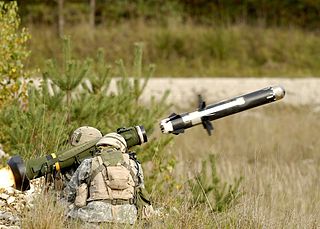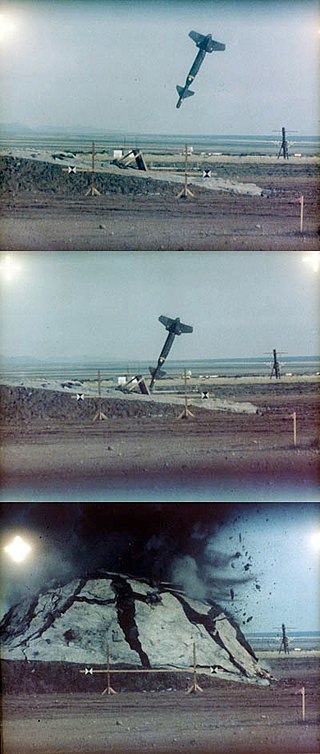Related Research Articles

An anti-tank guided missile (ATGM), anti-tank missile, anti-tank guided weapon (ATGW) or anti-armor guided weapon is a guided missile primarily designed to hit and destroy heavily armored military vehicles. ATGMs range in size from shoulder-launched weapons, which can be transported by a single soldier, to larger tripod-mounted weapons, which require a squad or team to transport and fire, to vehicle and aircraft mounted missile systems.

A wire-guided missile is a missile that is guided by signals sent to it via thin wires connected between the missile and its guidance mechanism, which is located somewhere near the launch site. As the missile flies, the wires are reeled out behind it. This guidance system is most commonly used in anti-tank missiles, where its ability to be used in areas of limited line-of-sight make it useful, while the range limit imposed by the length of the wire is not a serious concern.
Semi-automatic command to line of sight (SACLOS) is a method of missile command guidance. In SACLOS, the operator must continually point a sighting device at the target while the missile is in flight. Electronics in the sighting device and/or the missile then guide it to the target.

Javelin is a British man-portable surface-to-air missile, formerly used by the British Army and Canadian Army. It can be fired from the shoulder, or from a dedicated launcher named the Lightweight Multiple Launcher (LML), that carries three rounds, and can be vehicle mounted.

The BGM-71 TOW is an American anti-tank missile. TOW replaced much smaller missiles like the SS.10 and ENTAC, offering roughly twice the effective range, a more powerful warhead, and a greatly improved semi-automatic command to line of sight (SACLOS) that could also be equipped with infrared cameras for night time use.

Missile guidance refers to a variety of methods of guiding a missile or a guided bomb to its intended target. The missile's target accuracy is a critical factor for its effectiveness. Guidance systems improve missile accuracy by improving its Probability of Guidance (Pg).

Swingfire was a British wire-guided anti-tank missile developed in the 1960s and produced from 1966 until 1993. The name refers to its ability to make a rapid turn of up to ninety degrees after firing to bring it onto the line of the sighting mechanism. This means that the launcher vehicle could be concealed and the operator, using a portable sight, placed at a distance in a more advantageous firing position.

The FV102 Striker was the anti-tank guided missile carrier in the CVR(T) family and served in the British Army.
Command guidance is a type of missile guidance in which a ground station or aircraft relay signals to a guided missile via radio control or through a wire connecting the missile to the launcher and tell the missile where to steer to intercept its target. This control may also command the missile to detonate, even if the missile has a fuze.

The AGM-12 Bullpup is a short-range air-to-ground missile developed by Martin Marietta for the US Navy. It is among the earliest precision guided air-to-ground weapons and the first to be mass produced. It first saw operational use in 1959 on the A-4 Skyhawk, but soon found use on the A-6 Intruder, F-100 Super Sabre, F-105 Thunderchief, F-4 Phantom II, F-8 Crusader, and P-3 Orion in both Navy and US Air Force service, as well as NATO allies. The weapon was guided manually via a small joystick in the aircraft cockpit, which presented a number of problems and its ultimate accuracy was on the order of 10 metres (33 ft), greater than desired. In the 1960s it was increasingly supplanted by fully automatic weapons like the AGM-62 Walleye and AGM-65 Maverick.

The Vickers Vigilant was a British 1960s era MCLOS wire-guided anti-tank missile used by the British Army. It was also licence-built in the United States by Clevite for the US Marine Corps, and sometimes known as Clevite rounds in this case.

The 9M14 Malyutka is a manual command to line of sight (MCLOS) wire-guided anti-tank guided missile (ATGM) system developed in the Soviet Union. It was the first man-portable anti-tank guided missile of the Soviet Union and is probably the most widely produced ATGM of all time—with Soviet production peaking at 25,000 missiles a year during the 1960s and 1970s. In addition, copies of the missile have been manufactured under various names by at least six countries.

The 3M6 Shmel is an MCLOS wire-guided anti-tank missile of the Soviet Union. Its GRAU designation is "3M6" and its NATO reporting name is AT-1 Snapper.

The 9K111 Fagot is a second-generation tube-launched semi-automatic command to line of sight (SACLOS) wire-guided anti-tank missile system of the Soviet Union for use from ground or vehicle mounts. The 9K111 Fagot missile system was developed by the Tula KBP Design Bureau for Instrument Building. 9M111 is the designation for the missile. Its NATO reporting name is AT-4 Spigot.

The SS.11 is a French manual command to line of sight wire-guided anti-tank missile manufactured by Nord Aviation. It is also available in the air-to-ground version, AS.11, which featured a stabilized sighting system. The AS.11 was also known as the AGM-22 in American service. It is among the earliest guided anti-tank missiles, entering service with the French Army in 1956 and remaining in service into the 1980s. It also formed the basis for the larger and longer-ranged SS.12/AS.12 series.

The 9K112 Kobra is a SACLOS anti-tank missile system of the Soviet Union. It is fired from the 125 mm main guns of the T-64 and T-80 series of tanks. A newer design based on the same concept is the 9M119.

The RBS 56B BILL 2 Anti-Tank Guided Weapon is a man-portable or vehicle-mounted guided anti-tank missile using the overfly top attack method to attack the weaker parts of an armoured vehicle. BILL is acronym for Bofors Infantry Light & Lethal.

The Raad or RAAD is an Iranian wire-guided anti-tank guided missile based on the Soviet 9M14M Malyutka missile. The Raad began mass production in 1988 and was publicly unveiled in 1997. It is manufactured by Parchin Missile Industries, a subsidiary of Iran's Defense Industries Organization.

The Bantam or Robot 53 was a Swedish wire-guided, manual command to line of sight, anti-tank missile developed in the late 1950s by Bofors. It served with the Swedish and Swiss armies from 1963 and 1967 respectively. It can either be deployed by a single man carrying a missile and control equipment or from a vehicle. It has been fitted to the Volvo L3314 and the Scottish Aviation Bulldog. In the Swiss Army, it was mounted on Steyr-Daimler-Puch Haflinger light wheeled vehicles, as well as experimentally on a MOWAG Tornado IFV prototype
Predicted line of sight (PLOS) is a method of missile targeting. In PLOS, the operator tracks the target with the missile launcher's onboard sights for a short period of time. Software on the launcher extrapolates from the data gathered, producing a prediction of the route required to intercept the moving target. When fired the missile uses inertial navigation to fly this course and hopefully engage the target either by direct contact or via proximity fuse detonating the warhead. The method is used by the NLAW and FGM-172 SRAW anti-tank weapon.
References
- ↑ Iyer, N. R. (1995). "Recent Advances in Antitank Guided Missile Systems" (PDF). Defence Science Journal. 45 (3): 187–197.